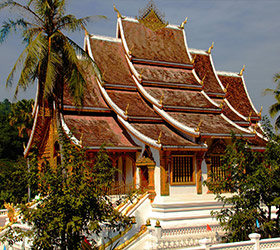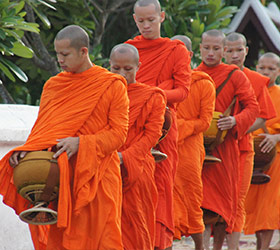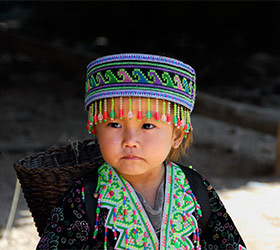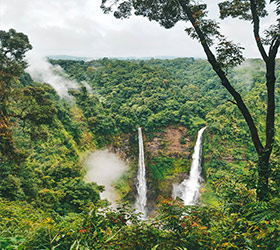Laos
All Destinations
Laos
Possessing an immensely peaceful and easy-going atmosphere, Laos is an undiscovered gem of South-East Asia.
Covered in resplendent jungle and speckled with ramshackle colonial towns and remote villages, tourism in Laos is less developed than some of its neighbours. This leaves the landscapes, historic sites and hill-tribes largely undiluted by the outside world and its distinct culture preserved.
Dominated by the tides of the mighty Mekong River, which runs through its heart, Laos is an entirely landlocked destination sharing five international borders, making it ideally suited to a multi country itinerary.
Over half of the country’s population follow the same traditions passed to them through centuries and some of the most stunning villages can be found on the gentle slopes of Northern Laos. The region also provides some of the best trekking opportunities in Indochina.
Luang Prabang, a little further south, is the country’s clear star attraction, sitting at the meeting point of the Mekong and Nam Khan rivers. The city is a treasure-trove of golden Buddhist temples and saffron robed monks in stark contrast to the elegant French cafes and peculiar boutiques dispersed between colonial homes. Nearby, tiered waterfalls plunge into spectacular azure pools surrounded by lush vegetation.
In the south you’ll discover the Khmer Hindu temple complex of Vat Phou, the Mekong’s Si Phan Don (Four Thousand Islands), rare Irrawaddy dolphins and the Bolaven Plateau, an elevated region crossed by several rivers dotted with picturesque waterfalls.
Diverse, bemusing and standing firm in retaining its own identity, Laos cannot fail to touch those who choose to visit her.
Quick Facts
Capital
Vientiane
Population
6.7 million
Area
236,800 sq km (91,400 sq miles)
Major Languages
Lao, French
Major religion
Buddhism
Monetary Unit
Kip
Flight time from London
15.5 hours via Bangkok
Time Difference
GMT + 7
As a land locked country, Laos’ weather system is unaffected by a coastline and can thus be divided in to two pretty straight forward seasons. The dry season lasts from October until April and the wet season from May to September. The hottest months of the year are the months leading to each season, March, April, May and June.
The altitude also affects the temperature and with the northern and central regions being a higher altitude than the south, the temperatures are considerably lower in areas of high altitude. The Mekong River valley, with the lowest altitude experiences considerably higher humidity and temperatures, reaching 35’C between March and April.
During the wet season, the early months are still very hot with less rainfall while later in the season the rain is heavier and more constant, particularly in the south. In Luang Prabang and the north you can expect lighter rainfall, often overnight and in the morning, followed by clearer afternoons. During the rainy season daytime temperatures hover around 29°C in the lowlands while the mountain valleys are a good 5° cooler.
As temperatures drops in the evening in all but the hottest months of the year, a jumper or wrap is advised as it can get much cooler.
- J
- F
- M
- A
- M
- J
- J
- A
- S
- O
- N
- D
- High Season
- Mid Season
- Shoulder Season
Highlights




Vientiane
Located on a curve of the Mekong River, Vientiane has a recorded history that stretches back to around 1,000 AD. The area was originally settled because of the fertility of the surrounding alluvial plains, and Vientiane became the capital city of Laos around the mid-16th century.
Vientiane is the home to the most significant national monument in Laos: That Luang (Great Stupa), which is the symbol of Lao and an icon of Buddhism in Laos. Of the many beautiful Wats in Vientiane, a visit to Wat Sisaket is a must; built in 1818, this is one of the oldest temples in Vientiane. Other Buddhist holy places are Wat Ong Teu Mahavihan, known for its 16th century bronze Buddha sheltered by a carved wooden masterpiece, and Wat Si Muang, the site of the Lak Meuang or pillar-stone of Vientiane. Wat Si Meuang is also home to the guardian spirit of the city. Hor Phakeo, across the street from Wat Sisaket houses a beautiful collection of Buddha statues, including traditional Lao style of the “Calling for Rain” and “Offering Protection”. Spend a morning in the Lao National Museum, which displays an interesting mixture of revolutionary and contemporary exhibitions. The main sights in Vientiane are only a short walk or bicycle ride from most hotels. Wat Xieng Khouan, better known as the Buddha Park should not be missed: take a tuk-tuk to this unique park that includes Buddhist and Hindu. Shopping for handicrafts is easy in Vientiane Capital; visit Talat Sao (morning market) for a wide range of colourful textiles including silks, wall-hangings and other decorative pieces. For very fine handicrafts, try one of the many upscale galleries in the city center. Keep your eyes open for traditional wood carvings, mulberry paper and a variety of basketry made from bamboo and rattan.
When you get hungry try the nation’s signature dish, tam mak-hung (spicy green papaya salad). laap (spicy minced meat salad) and ping kai (fried chicken). For its size, Vientiane is surprisingly multicultural and has excellent French, Indian, Thai, Chinese and Vietnamese restaurants that serve both Lao and specialty dishes. Quench your thirst with a refreshing Beer Lao or fresh fruit shake from one of the many small restaurants found along almost every street in town. At dusk, find a spot along the Mekong promenade to enjoy an amazing view of the sunset over the river.
The largest fair, Boun Pha That Luang, is held in Vientiane Capital around mid-November each year. Celebrations begin at Wat Si Muang followed by a procession to That Luang. Festivities last a full week, ending in fireworks on the last night, which coincides with the full moon. In mid-October, the riverbank overflows with spectators watching the annual boat races. Boun Ok Phansa or the last day of Buddhist Lent precedes the boat races by one day. In the evening of Boun Ok Phansa, Lao people prepare small banana leaf boats called heua fai and set them afloat on the Mekong illuminated by candles and incense in a charming ceremony meant to bring good luck and prosperity.





Luang Prabang
Situated in the centre of northern Laos, Luang Prabang is classified as a UNESCO World Heritage Site for its outstanding cultural, historic and architectural values and its harmonious relationship between the natural and built environment. In the 14th century, the King Fa Ngum founded the first Lao Kingdom, Lane Xang, here in Luang Prabang. Luang Prabang remained the capital of Lane Xang until 1565 when the capital was moved to Vientiane. It remained to serve as the country’s spiritual and religious centre. Visitors to Luang Prabang are charmed by the friendly atmosphere of this small town. The town itself offers several unique insights into the history of the region, through excellently preserved Buddhist temples, museum and a variety of Lao, Tai-Lue, Burmese, Chinese and Taui architecture Night Market. In Luang Prabang sell a large variety of traditional goods. The town is famous for its unique textiles and beautiful mulberry paper. Famous foods in Luang Prabang are “Aur Lam” (a thick stew made with the forst herb “Sakhan”, meat and eggplants), “Jaew Bong”, a sauce made with hot chillies and buffalo skin and “khai Pan” dried river weed lightly fried with sesame seeds and garlic.
Some of the most visited sites in Luang Prabang Town are Wat Xieng Thong, Mount Phou Si, Wat Visounnarath, the former Royal Palace and Wat Manolom. Equally beautiful are the lesser known temples across the Mekong River in Chomphet District. You can take a 1,5 hour walk through the hills and forest opposite the main town to explore the old temple sites and peaceful environment. Just outside of the main town are the beautiful Tad Kwang Si Waterfall, Tham Ting Caves, Ban Xang Hai Village and the tiered waterfall Tad Sae. Further out is muang Ngoi Kao, a quiet village located on the banks of the Nam Ou River surrounded by high karst mountains and sheer limestone cliffs. You can visit these sites on your own or use the services of one of the many tour operators based in town.
Luang Parbang celebrates all of the major Lao Festivals in style. The largest, Pi Mai Lao or Lao New Year takes place officially from 13-15 April, but in Luang Prabang the festival often lasts a full week with a trade fair, “Miss Lao New Year” contest, parades and religious ceremonies. In late December is Hmong New Year. This is a time where the Hmong show off their finest traditional clothing, hold musical performances and other cultural ceremonies. In Luang Prabang, the annual boat races are held in late September, one month earlier than Vientiane and most other places in the country.
While in Luang Prabang, you may observe the morning alms giving ceremony where monks walk through town in single file carrying their alms bowls to give laypeople the opportunity to offer alms and gain merit. Offerings by the people are usually comprised of sticky rice, fruit or simple traditional snacks. Know as “Binthabat” in Lao, this is a sacred religious ceremony. Tourists may participate in and photograph the ceremony, however, the people of Luang Prabang, especially the monks, ask that this is done is a respectful way and visitors do everything they can not to disrupt this ancient tradition.










Northern Laos
For many, Northern Laos is the highlight. Rural life and outdoor life are the key attractions to visitors, with opportunities for cycling, trekking, kayaking and ziplining as well as family homestays, this is a eco-adventure tourism mecca. Gibbons inhabit dense forests while a rich tapestry of vividly attired ethnic tribes populate the area.
Soaring mountains and curling valleys dominate the landscapes, cut by roads and rivers twisting and turning through endless essential bends. It is not surprising that many consider the best way to explore the area is by boat.
Key spots include the lazy town of Pakbeng sitting at the river’s edge. An overnight stop for cargo and ferrys travelling up the Mekong, it’s example of river life makes it a popular spot. The northernmost border crossing between Laos and Thailand, Huay Xai looks over the Mekong River, to Chiang Khong in the neighbouring and in Luang Namtha, trekking and mountain biking are the name of the game at the tiny Muang Sing, although seemingly isolated, popular due to its being just that. Tribal life can be found in likes of Hmong, Tai Dam, Akha, Tai Lue and Yao and a strong Chinese influence can be felt in Phongsali, with many of the locals descending from old Chinese Yunnan traders, mixing with local tribes.








Southern Laos
Often overlooked in favour of Laos’ better known Northern highlights, Southern Laos offers breathtaking landscapes, ancient temples, powerful waterfalls and relaxing islands.
With sleepy Pakse as its hub, the region is peaceful, laid back and entirely unique. The Mekong is the life blood of the region and for river lovers nothing beats taking a boat through the tranquil 4000 Islands located within an inland delta of the Mekong River.
To the East of Pakse lies the fertile Bolaven Plateau, famous for its cool climate, fruit and vegetable farms and high quality coffee. It’s a great place to experience local village life and learn about their rural livelihood.
Waterfalls are in abundance in Southern Laos, from the Niagara Falls of Southeast Asia, Khone Phapeng, to the picturesque Tad Fane, nestled in the highlands, amongst tea and coffee plantations.
Further south you’ll find the charming settlement of Champasak, home to the Pre-Ankorian temple of Wat Phou, designated a UNESCO World Heritage Site. Built between the 5th and 12th century and easily the most evocative Khmer ruins outside Cambodia, the rambling hilltop temple complex of Wat Phou is reason enough to venture down to southern Laos.




Vientiane
Located on a curve of the Mekong River, Vientiane has a recorded history that stretches back to around 1,000 AD. The area was originally settled because of the fertility of the surrounding alluvial plains, and Vientiane became the capital city of Laos around the mid-16th century.
Vientiane is the home to the most significant national monument in Laos: That Luang (Great Stupa), which is the symbol of Lao and an icon of Buddhism in Laos. Of the many beautiful Wats in Vientiane, a visit to Wat Sisaket is a must; built in 1818, this is one of the oldest temples in Vientiane. Other Buddhist holy places are Wat Ong Teu Mahavihan, known for its 16th century bronze Buddha sheltered by a carved wooden masterpiece, and Wat Si Muang, the site of the Lak Meuang or pillar-stone of Vientiane. Wat Si Meuang is also home to the guardian spirit of the city. Hor Phakeo, across the street from Wat Sisaket houses a beautiful collection of Buddha statues, including traditional Lao style of the “Calling for Rain” and “Offering Protection”. Spend a morning in the Lao National Museum, which displays an interesting mixture of revolutionary and contemporary exhibitions. The main sights in Vientiane are only a short walk or bicycle ride from most hotels. Wat Xieng Khouan, better known as the Buddha Park should not be missed: take a tuk-tuk to this unique park that includes Buddhist and Hindu. Shopping for handicrafts is easy in Vientiane Capital; visit Talat Sao (morning market) for a wide range of colourful textiles including silks, wall-hangings and other decorative pieces. For very fine handicrafts, try one of the many upscale galleries in the city center. Keep your eyes open for traditional wood carvings, mulberry paper and a variety of basketry made from bamboo and rattan.
When you get hungry try the nation’s signature dish, tam mak-hung (spicy green papaya salad). laap (spicy minced meat salad) and ping kai (fried chicken). For its size, Vientiane is surprisingly multicultural and has excellent French, Indian, Thai, Chinese and Vietnamese restaurants that serve both Lao and specialty dishes. Quench your thirst with a refreshing Beer Lao or fresh fruit shake from one of the many small restaurants found along almost every street in town. At dusk, find a spot along the Mekong promenade to enjoy an amazing view of the sunset over the river.
The largest fair, Boun Pha That Luang, is held in Vientiane Capital around mid-November each year. Celebrations begin at Wat Si Muang followed by a procession to That Luang. Festivities last a full week, ending in fireworks on the last night, which coincides with the full moon. In mid-October, the riverbank overflows with spectators watching the annual boat races. Boun Ok Phansa or the last day of Buddhist Lent precedes the boat races by one day. In the evening of Boun Ok Phansa, Lao people prepare small banana leaf boats called heua fai and set them afloat on the Mekong illuminated by candles and incense in a charming ceremony meant to bring good luck and prosperity.





Luang Prabang
Situated in the centre of northern Laos, Luang Prabang is classified as a UNESCO World Heritage Site for its outstanding cultural, historic and architectural values and its harmonious relationship between the natural and built environment. In the 14th century, the King Fa Ngum founded the first Lao Kingdom, Lane Xang, here in Luang Prabang. Luang Prabang remained the capital of Lane Xang until 1565 when the capital was moved to Vientiane. It remained to serve as the country’s spiritual and religious centre. Visitors to Luang Prabang are charmed by the friendly atmosphere of this small town. The town itself offers several unique insights into the history of the region, through excellently preserved Buddhist temples, museum and a variety of Lao, Tai-Lue, Burmese, Chinese and Taui architecture Night Market. In Luang Prabang sell a large variety of traditional goods. The town is famous for its unique textiles and beautiful mulberry paper. Famous foods in Luang Prabang are “Aur Lam” (a thick stew made with the forst herb “Sakhan”, meat and eggplants), “Jaew Bong”, a sauce made with hot chillies and buffalo skin and “khai Pan” dried river weed lightly fried with sesame seeds and garlic.
Some of the most visited sites in Luang Prabang Town are Wat Xieng Thong, Mount Phou Si, Wat Visounnarath, the former Royal Palace and Wat Manolom. Equally beautiful are the lesser known temples across the Mekong River in Chomphet District. You can take a 1,5 hour walk through the hills and forest opposite the main town to explore the old temple sites and peaceful environment. Just outside of the main town are the beautiful Tad Kwang Si Waterfall, Tham Ting Caves, Ban Xang Hai Village and the tiered waterfall Tad Sae. Further out is muang Ngoi Kao, a quiet village located on the banks of the Nam Ou River surrounded by high karst mountains and sheer limestone cliffs. You can visit these sites on your own or use the services of one of the many tour operators based in town.
Luang Parbang celebrates all of the major Lao Festivals in style. The largest, Pi Mai Lao or Lao New Year takes place officially from 13-15 April, but in Luang Prabang the festival often lasts a full week with a trade fair, “Miss Lao New Year” contest, parades and religious ceremonies. In late December is Hmong New Year. This is a time where the Hmong show off their finest traditional clothing, hold musical performances and other cultural ceremonies. In Luang Prabang, the annual boat races are held in late September, one month earlier than Vientiane and most other places in the country.
While in Luang Prabang, you may observe the morning alms giving ceremony where monks walk through town in single file carrying their alms bowls to give laypeople the opportunity to offer alms and gain merit. Offerings by the people are usually comprised of sticky rice, fruit or simple traditional snacks. Know as “Binthabat” in Lao, this is a sacred religious ceremony. Tourists may participate in and photograph the ceremony, however, the people of Luang Prabang, especially the monks, ask that this is done is a respectful way and visitors do everything they can not to disrupt this ancient tradition.










Northern Laos
For many, Northern Laos is the highlight. Rural life and outdoor life are the key attractions to visitors, with opportunities for cycling, trekking, kayaking and ziplining as well as family homestays, this is a eco-adventure tourism mecca. Gibbons inhabit dense forests while a rich tapestry of vividly attired ethnic tribes populate the area.
Soaring mountains and curling valleys dominate the landscapes, cut by roads and rivers twisting and turning through endless essential bends. It is not surprising that many consider the best way to explore the area is by boat.
Key spots include the lazy town of Pakbeng sitting at the river’s edge. An overnight stop for cargo and ferrys travelling up the Mekong, it’s example of river life makes it a popular spot. The northernmost border crossing between Laos and Thailand, Huay Xai looks over the Mekong River, to Chiang Khong in the neighbouring and in Luang Namtha, trekking and mountain biking are the name of the game at the tiny Muang Sing, although seemingly isolated, popular due to its being just that. Tribal life can be found in likes of Hmong, Tai Dam, Akha, Tai Lue and Yao and a strong Chinese influence can be felt in Phongsali, with many of the locals descending from old Chinese Yunnan traders, mixing with local tribes.








Southern Laos
Often overlooked in favour of Laos’ better known Northern highlights, Southern Laos offers breathtaking landscapes, ancient temples, powerful waterfalls and relaxing islands.
With sleepy Pakse as its hub, the region is peaceful, laid back and entirely unique. The Mekong is the life blood of the region and for river lovers nothing beats taking a boat through the tranquil 4000 Islands located within an inland delta of the Mekong River.
To the East of Pakse lies the fertile Bolaven Plateau, famous for its cool climate, fruit and vegetable farms and high quality coffee. It’s a great place to experience local village life and learn about their rural livelihood.
Waterfalls are in abundance in Southern Laos, from the Niagara Falls of Southeast Asia, Khone Phapeng, to the picturesque Tad Fane, nestled in the highlands, amongst tea and coffee plantations.
Further south you’ll find the charming settlement of Champasak, home to the Pre-Ankorian temple of Wat Phou, designated a UNESCO World Heritage Site. Built between the 5th and 12th century and easily the most evocative Khmer ruins outside Cambodia, the rambling hilltop temple complex of Wat Phou is reason enough to venture down to southern Laos.
Where to stay
These are just a selection of the properties we can personally recommend. Please get in touch to hear more about our full portfolio.
Amantaka
Set just south of Mount Phousi, Amantaka combines French-colonial elegance fused with timeless temple traditions.
Ansara
Ansara in Vietiane is a charming boutique hotel, set in the heart of Laos’ capital with just 24 rooms and four suites.
Belmond La Residence Phou Vao
With an enviable hilltop location overlooking the UNESCO city of Luang Prabang, Belmond La Residence Phou Vao is every ounce a luxurious colonial retreat.
La Folie Lodge
Set on the northwest side of tiny Dong Daeng Island in the middle of the mighty Mekong river, La Folie Lodge gives the wonderful opportunity to escape the outside world, relax by the pool and soak up the glorious sunsets.
Muang La Lodge
More than just a hotel, Muang La Lodge was created by its French-Lao owners to offer a unique experience in the north of Laos and at the same time, to involve the local village in the daily life of the Lodge.
Satri House
A stay at Satri House is like being hosted by royalty in a bygone era, designed with a style inspired by Lao culture in a truly relaxing environment.
The River Resort
The River Resort enjoys a lush setting amongst paddy fields and tropical gardens overlooking the vast expanse of the Mekong River.
Get in touch with us now to start planning your journey
Follow Us
Proudly ASSOCIATED WITH











